TxSSC
2014-2017 DAR Report
Findings on Safety and Security in Texas School Districts
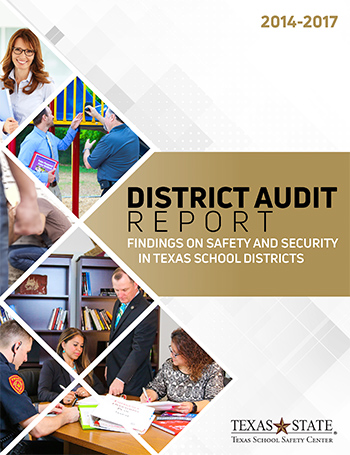
The purpose of the District Audit Report (DAR) is to provide key results of the safety and security audits completed by Texas public school districts. In accordance with procedures developed by the Texas School Safety Center (TxSSC) or an equivalent public or private entity, the Texas Education Code (TEC) requires districts to complete safety and security audits of their facilities once every three years (§37.108 (4)(b)). A summary of the findings is then submitted to the TxSSC and incorporated as aggregate data into a statewide report for the public (§37.108 (4) (c)) (§37.207(3)).
The TxSSC provides guidance for districts to develop safety and security audit procedures as well as tools to assist in the assessments. (§37.207 (1)). The TxSSC K-12 Safety and Security Audit toolkit includes step-by-step guidance and job aids for conducting audits, as well as comprehensive district facility audit checklists. The toolkit contains a series of spreadsheets utilizing specific evaluation statements for a variety of facilities and functions. These statements are a combination of best practices, promising practices, and/or requirements appropriate for certain types of facilities. The model safety and security audit procedures developed by the TxSSC are intended for use by districts to conduct a "self-assessment" of safety and security in their facilities. Neither the TEC nor administrative rules require that school district personnel conducting the audit hold a specific certification. Therefore, districts are encouraged to utilize their own personnel from various disciplines and include a cross-functional group of school personnel and collaborative community partners (e.g. local first responders).
While the term "audit" is included in TEC §37.108 and used throughout this report for consistency, the process was developed as an ongoing self-assessment of a district's safety and security. Audits should be an ongoing process of identifying specific district, campus or facility hazards, threats, and vulnerabilities and making improvements in safety and security plans and processes.
Methodology
The DAR provides a summary of safety and security information, which is comprised of self-reported data submitted by school districts in Texas, for the reporting cycle of September 1, 2014 through August 31, 2017. The TxSSC is authorized by the Texas legislature to determine the method used to collect the audit results, as well as the type of data necessary for collection. Data was collected via the DARtool, an online reporting application that was developed by the TxSSC and deployed using Qualtrics (an online survey tool). The DARtool allowed district superintendents or their designees to report specific audit information electronically to the TxSSC. Data from the DARtool were analyzed and reported at an aggregate level. Audit results submitted through means other than the online DARtool (e.g., hard copies or email) were not viewed or accepted.
“The DAR provides a summary of safety and security information, which is comprised of self-reported data submitted by school districts in Texas”
The TxSSC did not substantiate the data reported by districts and the accuracy of responses received from each district was presumed. Additionally, the TxSSC also took measures to safeguard the confidentiality of each reporting district by structuring the questions to protect against identification. According to TEC 37.108 (c-1), safety and security audit information is not subject to disclosure; however, certain exceptions regarding disclosure are permitted under TEC 37.108 (c-2).
The TxSSC attempted to collect audit information from 1,025 public school districts including Independent School Districts (ISDs), Common School Districts (CSDs), the Texas School for the Deaf, and the Texas School for the Blind and Visually Impaired. Since they do not fall under the TEC Chapter 37 reporting requirements, charter schools were not included in the reporting process.
Major Findings
A total of 1024 (99.9%) districts reported audit results via the DARtool for this cycle (2014-2017). The following section provides key findings from the safety and security audits of school districts in Texas.
- The majority of districts (94.8%) reported completing safety and security audits for all of their facilities (including both instructional and non-instructional) within the district.
- Of the districts that reported conducting safety and security audits for at least some of their facilities, more than half (62.4%) reported district/school employees or audit team members conducted their safety and security audits.
- Of the districts that reported conducting safety and security audits for at least some of their facilities, the majority (72.1%) reported using the Texas School Safety Center's safety and security audit procedures for their audits.
- The majority of the districts (88.9%) reported having a functioning School Safety and Security Committee.
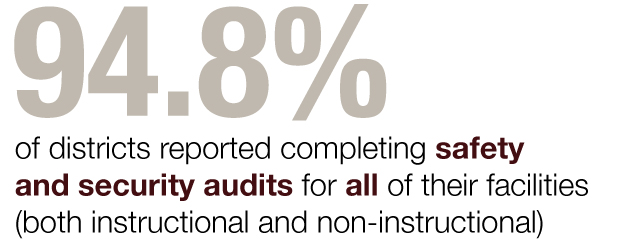
- A large majority of districts (95.3%) reported having a Multi-Hazard Emergency Operations Plan (EOP) in place. Additionally, almost all the districts (97.5%) reported their Multi-Hazard EOP addressed all four phases (mitigation/prevention, preparedness, response and recovery) of emergency management and is reviewed at least annually and updated as needed (95%).
- A majority of districts reported that Evacuation drills (98%) were mandated in their district's Multi-Hazard EOP, while 97% districts reported their EOP required weather drills, and 94% of districts indicated their EOP mandated lockdown drills. Additionally, 94% of districts reported their EOP mandated shelter drills and 91.6% of districts reported their EOP required reverse evacuation drills.
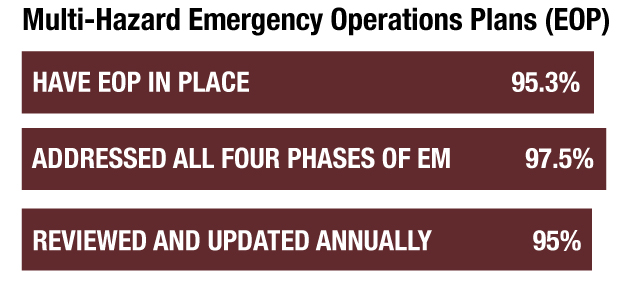
- Evacuation drills (89.6%) were most frequently conducted by districts at least once each year for all district facilities, while, 87% of districts reported conducting weather drills and 86.7% of districts reported conducting lockdown drills at least once each year for all district facilities. Further, 82.9% of districts reported conducting shelter-in-place drills and 73.3% of districts reported conducting reverse evacuation drills at least once each year for all district facilities.
- A majority of districts (92.5%) reported conducting after-action reviews following each drill, while 89.6% and 86.9% districts reported conducting after-action reviews following actual emergencies and exercises respectively.
- Over 98% districts indicated having identified key personnel that are responsible for specific emergency functions. Additionally, 60.9% districts reported these key personnel have been trained in the National Incident Management (NIMS), while 64.1% districts reported the key personnel have been trained in the Incident Command System (ICS).
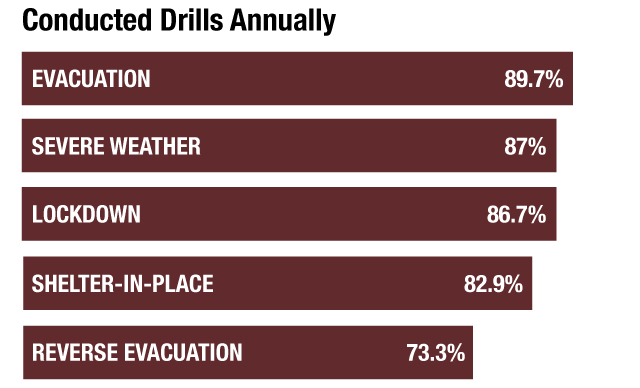
- A large majority of districts (99.2%) reported having a bullying prevention policy. Also, over 86% of districts reported having all the eight required components included in their district bullying prevention policy.
- Over 85% of districts reported having a suicide prevention plan. Further, 88.3% reported their suicide prevention plan is accessible to all students, staff, and parents at all district campuses.
- Over 75% of districts reported having used resources developed by the Texas School Safety Center during the past three-year audit cycle to support safety and security programs, plans or practices.
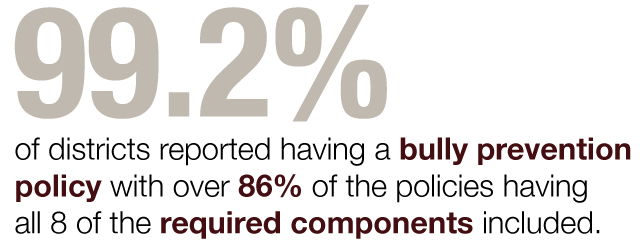
- Half of the districts (50%) reported school safety and security had improved to a great extent in their district since the last audit cycle, while 45.6% of districts indicated school safety and security had improved somewhat in their district since the last audit cycle.
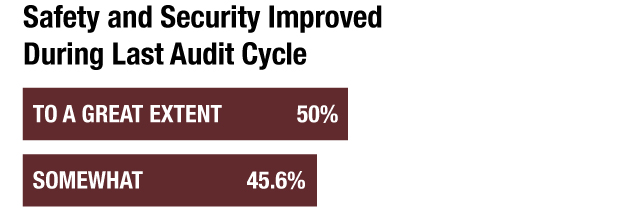
Recommendations
As has been the case, Texas school districts continue to work persistently toward keeping our children safe and secure, with the ultimate goal of ensuring the most conducive learning environments. This is even more evident considering the information collected in 2014-17 District Audit Report, which suggests the majority of Texas public school districts are implementing safety and security measures required under Chapter 37.108 of the Texas Education Code, as well as guidance and best practices. The following recommendations are proposed to further assist schools in their pursuit of safe and secure learning environments.
- School Districts Should Implement Collaborative and Integrated Emergency Management Programs
The foundation of a strong and effective emergency management program is collaboration and integration both internally and externally. With that, school districts should ensure that their emergency management programs are collaborative within and across district facilities as well as integrated into local, county and regional emergency management efforts. - School Districts Should Engage in Comprehensive Emergency Management Activities Across the District
Districts should ensure that comprehensive emergency management activities occur throughout the district. Specifically, school districts should ensure a detailed and high-quality Multi-Hazard EOP. This includes developing a plan that is mapped to specific threats and hazards and one that is updated as needed, but at least annually. The plan must, in accordance with TEC §37.108 (a), address all four phases of emergency management. - School Districts Should Make the Audit Process an Ongoing Self-Assessment Aimed at Providing the Safest Environments for our Children to Learn
Districts should make the audit process an ongoing self-assessment aimed at providing the safest environments for our children to learn. The TEC §37.108 states that at least once every three years, each school district shall conduct a safety and security audit of the district's facilities, and to the extent possible, a district shall follow safety and security audit procedures developed by the Texas School Safety Center or a comparable public or private entity. - School Districts Should Ensure Appropriate Resources, Training, and Policies are in Place to Support a Safe and Supportive Learning Environment for Students
Districts should continue to ensure appropriate resources, training, and policies are in place to support a safe and supportive learning environment. Safety and security is multi-pronged and includes a number of different areas, issues, and considerations. There are the more obvious physical and environmental safety and security issues that might be easy to see or experience, but there are also interpersonal as well as social and emotional safety and security considerations that districts should consider that might not be as apparent. Therefore, districts should examine safety and security comprehensively and look to provide resources, training, and policies that support a prepared and positive school climate.